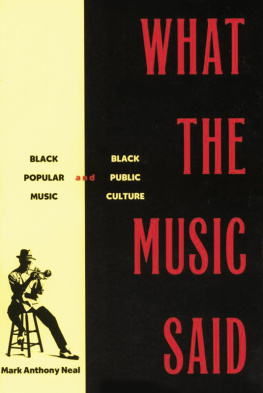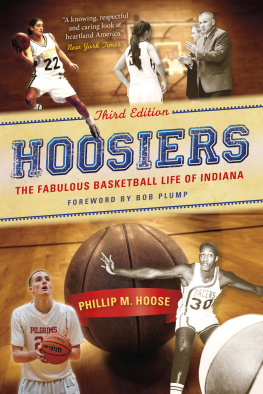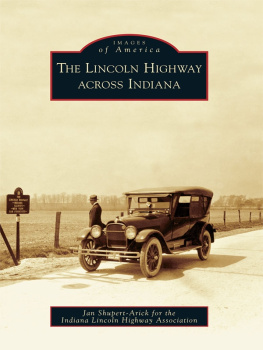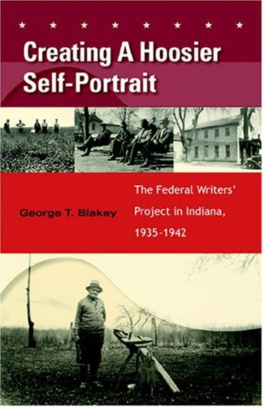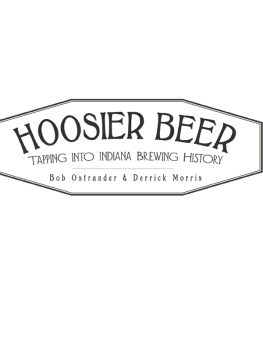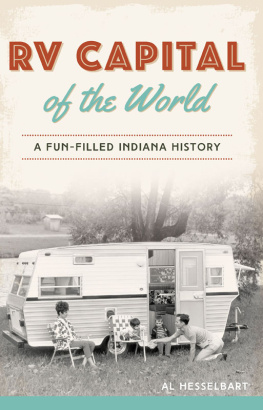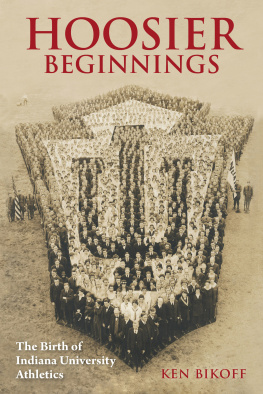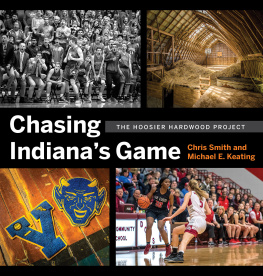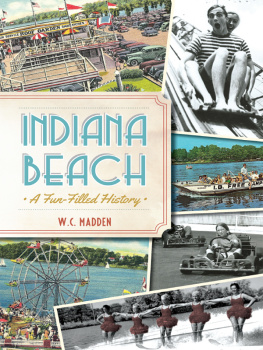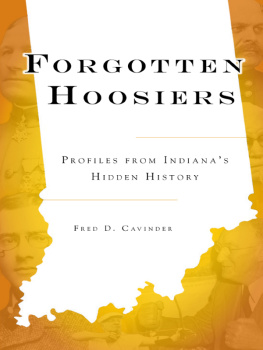The paper in this publication meets the minimum requirements of American National Standard for Information SciencesPermanence of Paper for Printed Library Materials, ANSI Z39. 481984
No part of this publication may be reproduced, stored in or introduced into a retrieval system, or transmitted, in any form or by any means (electronic, photocopying, recording, or otherwise) without the prior written permission of the copyright owner.
A Message from the IHS President
In August 1915 author Theodore Dreiser and artist Franklin Booth, both Indiana natives, set off from New York City in a sixty-horsepower, Hoosier-made Pathfinder touring car on a trip that brought Dreiser home after a more than twenty-year absence. It had been one of my dearly cherished ideas, Dreiser wrote, that some day, when I had the time and the money to spare, I was going to pay a return visit to Indiana.
The result of the two-week, 2,000-mile journey was a book, A Hoosier Holiday , published in Indianas 1916 centennial year. Dreisers work helped inaugurate an era of highway literature or road books, inspiring others to hit the road in their cars and visit long-forgotten destinations of their past.
It seems more than appropriate in 2016, to help commemorate the bicentennial of Indianas statehood, that the Indiana Historical Society follow, as it were, in Dreisers tire tracks by publishing Andrea Neals Road Trip: A Pocket History of Indiana . Andreas book is an open invitation for those who now live in the state, and Hoosiers from all over the country, to rediscover the historic sites and landmarks where Indiana history was made.
There is always, of course, more to learn about the nineteenth states past. We encourage those who visit the one hundred locations in this book, and want to know more about Indianas history, to visit the IHSs Destination Indiana online portal (http://www.destination-indiana.com/). Here you will discover stories from all of the states ninety-two countiesone to five journeys for each oneand tales about African Americans, the Civil War, the Ohio River, mapping the state, social justice and reform, notable Hoosiers, art, literature, transportation, and agriculture. What is your 2016 destination?
Sincerely,

John A. Herbst
President and CEO
Indiana Historical Society
Contents
Preface
As a teacher of U.S. history, I appreciate road trips. It is one thing to read about the War of 1812 in a textbook; it is another to walk across the field where William Henry Harrisons troops defeated The Prophets forces at the Battle of Tippecanoe.
This book was designed to get Hoosiers to take road trips during the states bicentennial. It is an effort to boil down centuries of history into bite-size stories reflecting the top 100 events, figures, and places every Indiana citizen should know.
From the beginning, I wanted to reach as many people as possible with these stories of our past, recognizing that few of us learned Indiana history beyond fourth grade, the age when it is taught in schools. Sad to say, we are woefully ignorant of our own story.
Craig Ladwig at the Indiana Policy Review Foundation, a nonprofit think tank headquartered in Fort Wayne, embraced the idea. He agreed to offer the articles free of charge to his newspaper distribution list beginning in the summer of 2013. The material was not the foundations typical fare, but Craig has always believed that good policy, regardless of politics, should be made only by those who know and understand their history.
Early reviews from readers were so encouraging that I approached Indiana Historical Society president and CEO John Herbst about the possibility of compiling the pieces into a book. To my delight, he and IHS Press senior director Ray E. Boomhower made it happen.
The biggest challenge was to narrow down the possible subjects to 100. At least half the topics were slam dunks, stories so significant that they would make any historians list, such as the writing of Indianas 1816 constitution, the removal of Native Americans from the land of the Indians, and the wars that have been the constant theme of human history no matter the location.
For variety, I searched out less-familiar stories that deserve to be widely known, such as draining the Grand Kankakee Marsh and the role played by Hoosier Horace Hickam in the establishment of the U.S. Air Force.
One caveat was that every article had to have a destination attached: a museum, monument, county historical society, park, sculpture, or annual event that Hoosiers could attend or visit so that the history would come alive in their minds eye. In some instances, I settled for historic markers when the landmark itself was no longer standing, for example at the site of the Dublin, Indiana, womens rights convention.
I began my stories during the Ice Age because thats how James H. Madison began his two definitive surveys of Indiana history: The Indiana Way (1986) and Hoosiers: A New History of Indiana (2014). Those two books were my most trusted advisers in the research and writing process.
I am thankful to attorney Ed Harris and my former newspaper colleague Kim Hooper, who did the legwork on several topics in their areas of expertise; to Laura Harris for her photographic skills at Columbus, Indiana, Wendell Willkie Park, and other spots that demanded an artistic eye; and to retired government and history teacher Tom Brogan, who accompanied me to many heritage sites referenced in this book. He and I were routinely amazed by destinations that we had no idea existed in our home state, despite a combined 110 years living here. On multiple occasions we walked away from a place saying, Now thats the best-kept secret in Indiana.
For readers who intend to use this book as a travel guide, please go online or make a phone call to check directions, admission prices, and hours of operation before setting off on your own adventures. I discovered early in the process that some of the more unusual destinations are operated seasonally and/or by volunteers, and the operating hours change frequently.
I speak on behalf of all Hoosiers in expressing appreciation for the folks who keep those places running out of their deep love of Indiana and its heritage. May more Hoosiers come to their aid in coming years so that all the places I describe in this book are alive and well for the states 250th birthday in 2066.
1. The Ice Age Made Modern Indiana
Long before Indiana was Indiana, a river of ice glided across the state, bringing with it monsoon-like rains, mudflows to rival Mount Saint Helens, and rich sediment deposits that to this day nourish the crops that are the backbone of the Hoosier economy.
Indiana the state has been two hundred years in the making. Indiana the place goes back two million years to a time when ice sheets blanketed the middle latitudes and shaped the landscape we know today.



